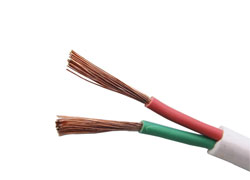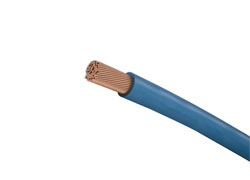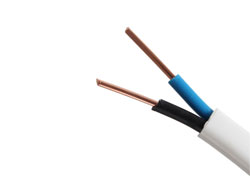1, each computer power consumption is about 200 ~ 300W (about 1 ~ 1.5A), then 10 computers need a 2.5 square mm copper wire power supply, otherwise there may be a fire.
2. The air power consumption of the big three air conditioners is about 3000W (about 14A), then a single air conditioner needs a separate 2.5 mm2 copper core wire to supply power. # c8 u u S1 a/ x# B
4 `! \" A&P( H) R g _3. The current line for housing is generally 4 square millimeters of copper wire. Therefore, household appliances that are turned on at the same time must not exceed 25 A (that is, 5,500 watts). Someone will wire the house. It is useless to replace the 6 mm2 copper wire, because the wire entering the meter is 4 mm2.* }9 {1 i( )" c& W6 \& J* X0 U
4. Early housing (15 years ago) The incoming line is generally 2.5 square millimeters of aluminum wire. Therefore, household appliances that are turned on at the same time must not exceed 13 A (2,800 watts).
5. Household appliances with relatively large power consumption are: air conditioner 5A (1.2 horsepower), electric water heater 10A, microwave oven 4A, rice cooker 4A, dishwasher 8A, washing machine 10A with drying function, electric water boiler 4A% K% u9 l: Z$ v( d5 P! }
90% of power-related fires are caused by joint heating, so all joints must be welded. Contact devices that cannot be soldered must be replaced within 5 to 10 years (such as sockets, air switches, etc.).
National standard allowable long-term current
4 square is 25-32A
6 square is 32-40A
7}5 d"N' w8 a+ L9 s& |, D* M These are theoretical safety values, and the limit value is greater than these, $ a/ x1 K/ W; K$ l+ g
The maximum power allowed for the 2,5 square copper wire is: 5500W. 4 square 8000W, 6 square 9000W no problem.
40A digital power meter normal 9000W absolutely no problem. The mechanical 12000W will not be burned.
Copper core wire and cable current carrying capacity of standard cable current-carrying port:
# H* p& k1 V2 Y Estimation:
Multiply the number by 9.5 and increase the number by 9. , P0 X- z+ N+ u# q$ `
Thirty-five to three-by-five, and both teams lose five points. P4 P$ |; u) t. ^7 S8 J
The conditions are changed and converted, and the high temperature 10% copper upgrade. y! x. k) ?* n$ m' C9 E
The number of pipes worn was 234, and the full load was 876.
4 G! s) b" T/ J Instructions:
In this section, the current-carrying capacity (safety current) of various insulated wires (rubber and plastic insulated wire) is not directly indicated, but is represented by “multiply the cross-section by a certain factor”, which is calculated by mental arithmetic.
“Five to multiply by two at five, and one at a time to go down” is to say that various sections of aluminum-core insulated wire with a diameter of 2.5 mm or less have a current carrying capacity of approximately 9 times the number of sections.
For a 2.5mm' wire, the current carrying capacity is 2.5 x 9 = 22.5 (A).
The multiple of the current-carrying capacity and the number of cross-sections of the conductors from 4mm' and above is the row along the line number, and the multiple is successively reduced by l, that is, 4x8, 6x7, 10x6, 16x5, 25x4.
"Five times by 3.5, both groups minus five points," said 35mm" wire carrying capacity is 3.5 times the number of sections, that is, 35 × 3.5 = 122.5 (A).
For a conductor of 50mm' or more, the multiple relationship between the current carrying capacity and the number of sections becomes a group of two two line numbers, and the multiple is successively decreased by 0.5. That is, the current carrying capacity of 50 and 70mm' wires is 3 times of the number of cross-sections; 95, 120mm" wire carrying capacity is 2.5 times of the cross-sectional area, and so on.
Wire and cable basic knowledge training
"Conditions are subject to change, high temperature 10% copper upgrade". The above-mentioned mouthpiece is made of an aluminum core insulated wire and an open coating under the condition of an ambient temperature of 25°C.
If the aluminum core insulation wire is deposited in an area where the ambient temperature is higher than 25°C for a long time, the wire carrying capacity can be calculated according to the above formula, and then it can be used for 10%. When the aluminum wire is used instead of the aluminum wire, the copper core wire is used. Its ampacity is slightly larger than that of the aluminum wire of the same specification. The ampacity method can be used to calculate the ampacity of a line number larger than that of the aluminum wire. For example, the current carrying capacity of 16mm' copper wire can be calculated by 25mm2 aluminum wire.
Calculate the cable current-carrying selection cable (according to the current selection cable):
The current-carrying capacity of the wire is related to the section of the wire. It is also related to the wire's material, model, laying method, and ambient temperature. There are many factors that affect the wire and the calculation is also complicated. The current carrying capacity of various wires can usually be found in the manual. However, with the use of oral prescriptions and some simple mental arithmetic, it can be directly calculated without having to look up the table. O; z7 t5 p3 L2 W- y
1. The relation between the current carrying capacity of aluminum insulated wire and the cross section' {4 k! A6 d7 i) v4 ]
10 in the next five, 100 in the second,
25, 35, Four, Three Realms, .8 V" G) @ ]& n- g( T3 S$ I
70, 95, two and a half times. % I$ i* p% J# v, {7 o) r
Wear tube, temperature, 80% off.
Bare line plus half.
Copper upgrade calculation.
Note that the ampacity does not directly indicate the ampacity of various cross-sections, but is expressed by multiplying the cross-section by a certain multiple.
For this purpose, the nominal cross section (square millimeters) of commonly used conductors in China is ranked as follows: # G. C& s+ y" e! q8 [7 q
1, 1.5, 2.5, 4, 6, 10, 16, 25, 35, 50, 70, 95, 120, 150, 185...) @) P) s1 o! Y4 ~
(1) The first sentence indicates that the current carrying capacity of the aluminum core insulated wire (A) can be calculated as a multiple of the cross section.
The Arabic numerals in the mouth indicate the conductor cross-section (square millimeters), and the Chinese character number indicates a multiple. The relationship between the cross section of the mouth and the multiples is as follows:
1~10 16, 25 35, 50 70, 95 120 or more (i" T- B; V & @ 6 F
Five times Four times Three times Two times and a half Double 'q; Y, o/ t* v5 r
It is now even clearer to speak with your mouth. The “10 under 5” in the mouth means that the cross section is below 10, and the current carrying capacity is five times that of the cross section. "100 on the second" (read the second on the second) refers to more than 100 cross-section of the ampacity is the cross-sectional value of twice. Sections 25 and 35 are four and three times the boundaries. This is the word "25, 35, four or three circles." The sections 70 and 95 are 2.5 times. From the above arrangement, it can be seen that except for 10 or more and 100 or more, the middle conductor cross section is the same multiple for each of the two specifications. 0 e. `3 d& Y8 n1 h5 X% A
For example, when the ambient temperature is not greater than 25°C, the calculation of the current-carrying capacity of the aluminum-core insulated wire is as follows:
When the section is 6 square millimeters, calculate the current carrying capacity is 30 A;
When the section is 150 square millimeters, the calculated current-carrying capacity is 300 A; 3 g) D3 P4 l& w# q1 h$ d
When the section is 70 square millimeters, the calculated current-carrying capacity is 175 A;
From the above arrangement, it can also be seen that the multiple decreases as the cross-section increases, and the error is slightly larger at the transition of the multiple. For example, sections 25 and 35 are four times and three times the boundaries, and 25 are four times the range. It is calculated as 100 amps, but the manual is 97 amps, and 35 is the opposite, and the verb is calculated as 105 amps. The check list is 117 amps. However, this has little effect on use. Of course, if you can "get in the chest," when choosing a conductor section, 25 will not allow it to reach 100 amps, and 35 will be slightly more than 105 ampere. Similarly, 2.5 square millimeters of wire position is five times more than the beginning, actually more than five times (up to 20 amps or more), but in order to reduce the power loss in the wire, the current is usually not used so much, the manual is generally only marked 12 security.
(2) The last three sentences are the treatment of changing conditions.
“Through pipe, temperature, eighty percent and ninety percent off” means: If the pipe is laid (including the laying of slot boards, ie, the conductors are covered with protective jackets, and the exposed ones are unclear), after calculation, the price will be discounted by 20%; if the ambient temperature exceeds After 25 °C, calculate 10% discount. If you wear the tube and the temperature exceeds 25 °C, you can play 10% discount and then use 10% discount. 7 k) x7 v0 N# R0 Q# f% q& L
With regard to the ambient temperature, it is defined as the average maximum temperature of the hottest months in summer. In fact, the temperature is variable, and in general, it does not affect the wire carrying current. Therefore, discounts are only considered when certain warm workshops or hotter areas exceed 25°C.
For example, the calculation of the download flow of insulated wire with aluminum core under different conditions:
When the cross-section is 10 mm2, the current-carrying capacity is 10×5×0.8═40 A; if the temperature is high, the current-carrying capacity is 10×5×0.9═45 A. If the tube is high-temperature, the current-carrying capacity is 10×5×0.7═35A.
K1 `$G/ \+ h/ c8. (3.) For the current carrying capacity of bare aluminum wire, the port indicates that the "bare wire plus half" is calculated and then added half. This means that the same sectional bare aluminum wire is compared with the aluminum core insulated wire and the current carrying capacity can be increased by half.
For example, the calculation of the current capacity of bare aluminum wire:
When the cross section is 16 square millimeters, the current carrying capacity is 16×4×1.5═96 amps. If the temperature is high, the current carrying capacity is 16×4×1.5×0.9=86.4 amps.
W! B. (4) For the copper wire current carrying capacity, the port indicates “copper wire upgrade calculation”, that is, the order of the cross-section of the copper wire is increased by one step, and then calculated according to the corresponding aluminum wire condition.
For example, the cross-section of 35 square millimeters of bare copper wire ambient temperature of 25 °C, the calculation of the ampacity: According to the upgrade to 50 square millimeters of bare aluminum wire is 50 × 3 × 1.5 = 225 amps.
For cable, there is no description in the mouth. Generally directly buried high voltage cables can be directly calculated using the relevant multiples in the first statement. For example, a 35mm square high-voltage armoured aluminum core cable has a current-carrying capacity of 35 x 3 = 105A. 95 square millimeters is approximately 95×2.5 inches and 238 amps. ; `4 V+ C* A# I# w# v
The section of the zero line in the three-phase four-wire system is usually selected to be about 1/2 of the phase section. Of course it must not be less than the minimum cross section allowed by the mechanical strength requirements. In a single-phase line, since the load currents passed by the neutral line and the phase line are the same, the cross-section of the zero line should be the same as the cross-section of the phase line.





